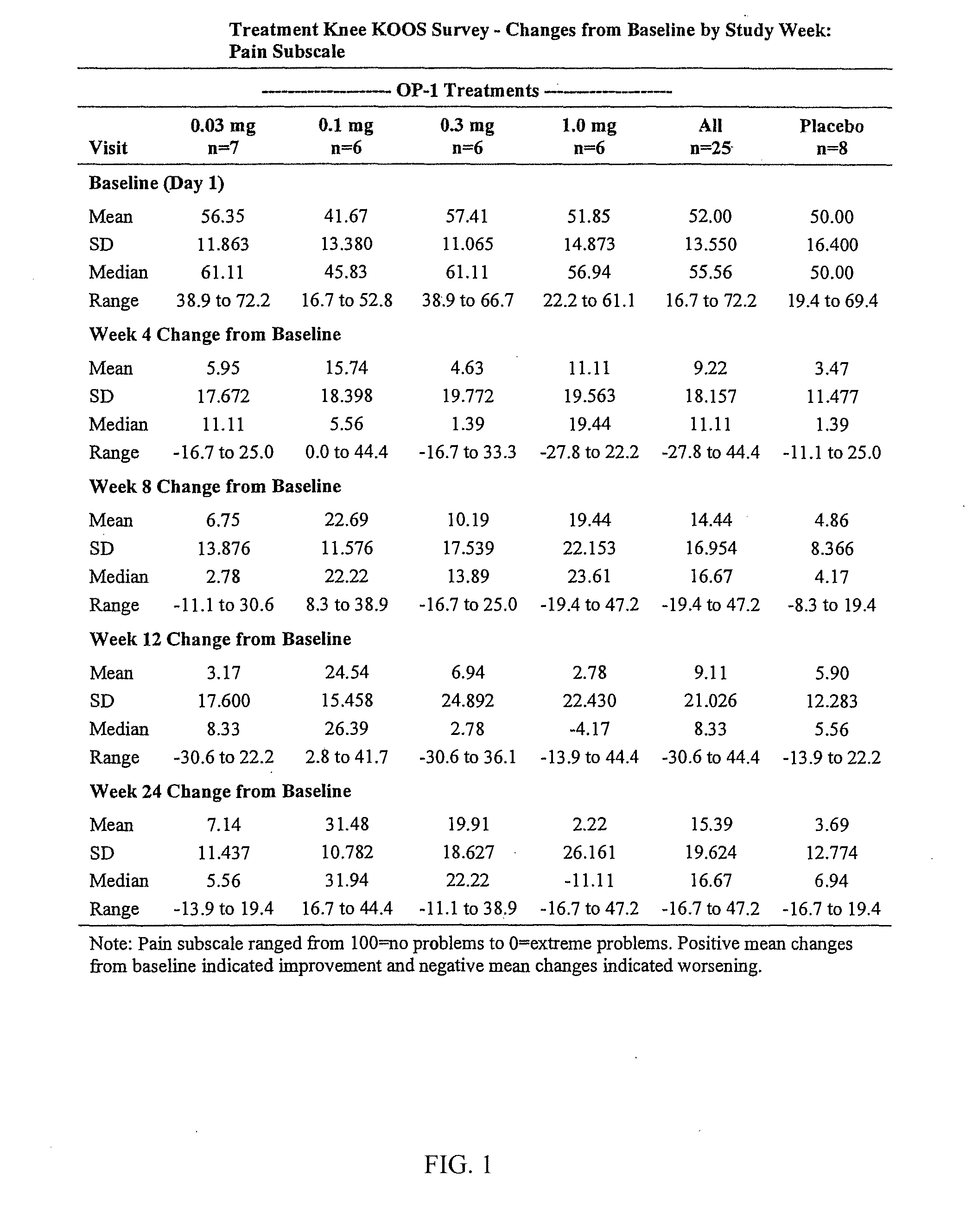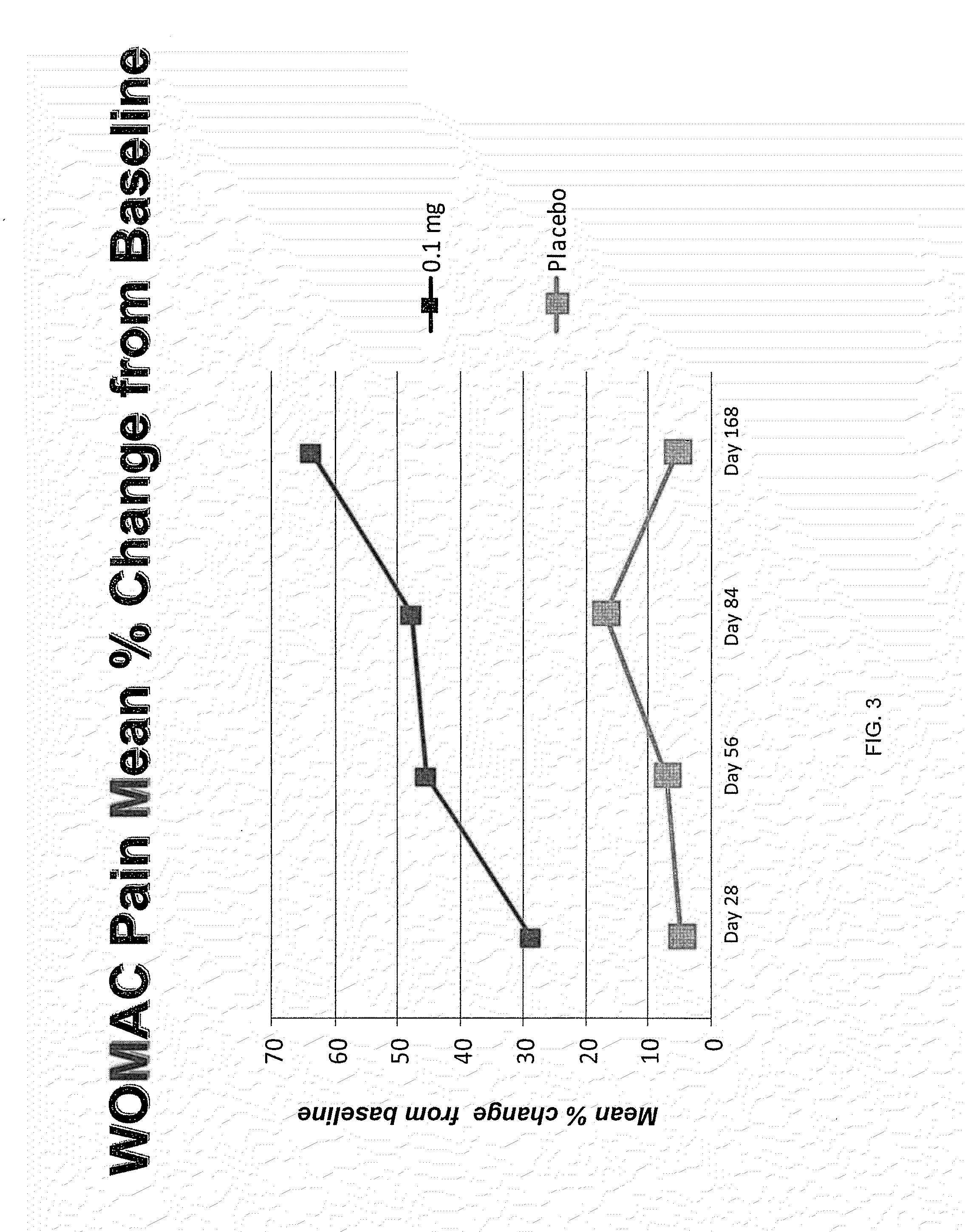Methods for treating pain induced by injuries and diseases of an articular joint
a technology for articular joints and diseases, applied in the direction of osteogenic factors, peptide/protein ingredients, drug compositions, etc., can solve the problem that the dose of bone morphogenetic proteins is not effective in promoting substantial cartilage growth in the joint, and achieves the effects of reducing pain, reducing inflammation, and improving joint function
- Summary
- Abstract
- Description
- Claims
- Application Information
AI Technical Summary
Benefits of technology
Problems solved by technology
Method used
Image
Examples
example 1
Determining the Alkaline Phosphatase Activity of OP-1
[0055]In order to determine the alkaline phosphatase activity of OP-1 (BMP-7), Ros 17 / 2.8 Cells were seeded in a 96 well plate at 3.7×105 cells per well and incubated at 37° C., 5% CO2 for 24 hours. Bulk OP-1 reference standard (Stryker Biotech, Hopkinton, Mass.) and samples were diluted to 30 μg / ml and serial diluted 6-fold with F-12 BSA. 50 μl (30 μg / ml) of reference standard and test samples were added to the cells which contained 200 μl of medium. The final protein concentration on the cells is 6 μg / ml diluted 6-fold as shown in the plate map in Table 1 below. The reference standard and the test samples were incubated on the cells for 24 hours at 37° C., 5% CO2. After incubation 150 μA of waste medium was removed from the cells and 100 μA of 2% Triton X-100 was added to lyse the cells. The lysed cells were incubated at 37° C., 5% CO2 for 1 hour.
[0056]The lysed plates were spun at 2600 RPM for 10 mins. 20 μA of the lysate was r...
example 2
Preparing an OP-1 Formulation for Administration to OA Patients
[0057]Recombinant human OP-1 (also known as BMP-7 or by the International Non-proprietary Name eptotermin alfa) was supplied as 1.0 mg lyophilized cake in 6 mL vials (Stryker Biotech LLC, Hopkinton, Mass.). Each cake was reconstituted with 1.0 mL sterile water resulting in a solution containing 1.0 mg / mL OP-1 in 5% lactose (weight / volume). Vials of OP-1 were diluted as needed with 5% lactose solution in order to arrive at 0.03 mg / mL, 0.1 mg / mL, and 0.3 mg / mL respectively.
example 3
Administration of OP-1 Formulation to a Patient
[0058]Recombinant human OP-1 or a placebo was administered to 33 subjects in 4 cohorts. Six subjects in each cohort were randomly assigned to receive 0.3 mg (7 subjects), 0.1 mg, 0.3 mg, or 1.0 mg of OP-1. Two subjects in each cohort were randomly assigned to receive a placebo of 1 mL 5% lactose. On day 1, a total volume of 1.0 mL containing the specified dose or placebo for each study cohort was injected intraarticularly into the knee using a 3 mL syringe under ultrasound or fluoroscopy guidance to ensure injection into the knee joint. Subjects underwent a 168 day (24 week) follow-up period. No further administration of OP-1 or placebo occurred after the initial injection on Day 1.
PUM
| Property | Measurement | Unit |
|---|---|---|
| time | aaaaa | aaaaa |
| time | aaaaa | aaaaa |
| time | aaaaa | aaaaa |
Abstract
Description
Claims
Application Information
 Login to View More
Login to View More - R&D
- Intellectual Property
- Life Sciences
- Materials
- Tech Scout
- Unparalleled Data Quality
- Higher Quality Content
- 60% Fewer Hallucinations
Browse by: Latest US Patents, China's latest patents, Technical Efficacy Thesaurus, Application Domain, Technology Topic, Popular Technical Reports.
© 2025 PatSnap. All rights reserved.Legal|Privacy policy|Modern Slavery Act Transparency Statement|Sitemap|About US| Contact US: help@patsnap.com



